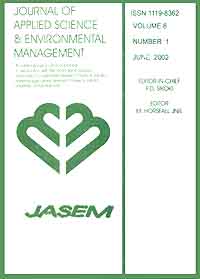
|
Journal of Applied Sciences and Environmental Management
World Bank assisted National Agricultural Research Project (NARP) - University of Port Harcourt
ISSN: 1119-8362
Vol. 15, No. 1, 2011, pp. 75 -78
|
 Bioline Code: ja11015
Bioline Code: ja11015
Full paper language: English
Document type: Research Article
Document available free of charge
|
|
|
Journal of Applied Sciences and Environmental Management, Vol. 15, No. 1, 2011, pp. 75 -78
| en |
Levels of Petroleum Hydrocarbons and some Heavy Metals in Tissues of Tympanotonus fuscatus  periwinkles from Warri river of Niger Delta Area of Nigeria periwinkles from Warri river of Niger Delta Area of Nigeria
Nwabueze, A.A.; Nwabueze, E.O. & Okonkwo, C.N.
Abstract
The levels of petroleum hydrocarbons and some heavy metals in the tissues of Tympanotomus fuscatus periwinkle from Warri River of Niger Delta area were investigated. Six hundred samples of periwinkles collected fortnightly for a period of six months from three stations (Jala. Ubeji and Suoroagbene-control) along Warri River were analyzed using Atomic Absorption Spectrophotometry for the determination of heavy metals. The mean levels of total hydrocarbon varied from 0.0045mg/g to 0.093 mg/g and mean lead (Pb) levels varied from 0.0023 ppm to 0.046 ppm. Mercury (Hg) and Cadmium (Cd) were below the instrument detection limit of <0.001 ppm in all three stations. The levels of total hydrocarbon at Jala and Ubeji were significantly (P < 0.05) higher than at Suoroagbene, the control station. The level of lead at Suoroagbene was significantly lower (P < 0.05) than at Jala and Ubeji. The higher levels of total hydrocarbon and lead in tissues of periwinkles from Jala and Ubeji were attributed to more industrial activities and close proximity of the stations to the major road where emission from automobiles abound more than Suoroagbene, which is purely a residential area. This study demonstrated the evidence of bioaccumulations of total hydrocarbons and lead but levels were below the recommended tolerable levels and also lower than levels reported previously in periwinkle tissues by some authors in same river. This implies that periwinkles from Warri River are safer now than before as a food source for consumers who delight in this delicacy. However, constant monitoring of water bodies receiving effluents is emphasized in order to forestall cumulative effects of pollutants which may lead to sub-lethal consequences in the aquatic fauna and clinical poisoning to man.
|
| |
© Copyright 2011 - Journal of Applied Sciences & Environmental Management
|
|
